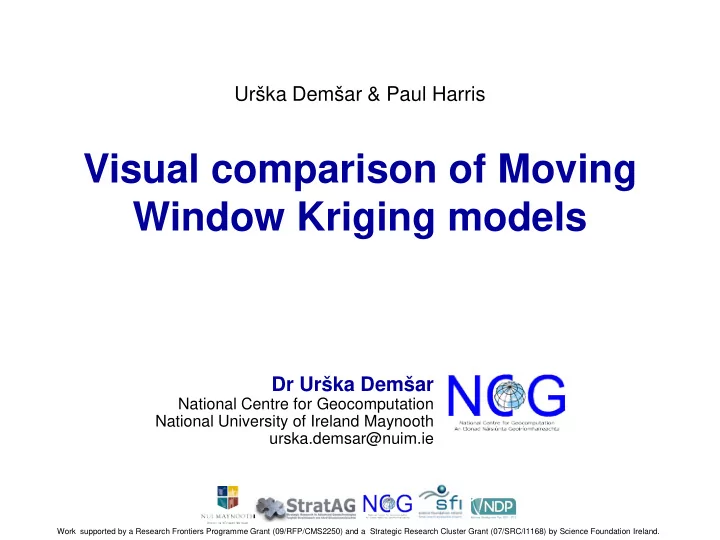

Urška Demšar & Paul Harris Visual comparison of Moving Window Kriging models Dr Urška Demšar National Centre for Geocomputation National University of Ireland Maynooth urska.demsar@nuim.ie Work supported by a Research Frontiers Programme Grant (09/RFP/CMS2250) and a Strategic Research Cluster Grant (07/SRC/I1168) by Science Foundation Ireland.
Moving Window Kriging (MWK) Semi-variance Kriging = geostatistical interpolation method Standard kriging = global Distance variogram z 3 z 1 z 2 Weights w i defined through variography n z 4 Estimate value at z(x)= Σ w i z z(x) an unknown location i=1 i z n Interpolation results Moving Window Kriging = simple kriging, variogram changes by location Predicted value Method parameters: kriging standard error & These become a set of other uncertainty dependent on measures location Multivariate spatial data set
Four MWK models – application of robustness Model 1: MW-SK – not robust Moving Window Kriging with Simple Kriging (SK) Outliers in the data Use a robust version of the method: resistant to poor results produced by deviation from assumptions Violated assumptions Unreliable results Box-Cox transform Model 2: ROB1 - robust 1. globally Box-Cox transform the data 2. locally estimate and model robust (not basic) variograms using the transformed data 3. locally apply the four sub-stages of a robust form of SK 4. back-transform the robust SK results to the original data space. Model 3: ROB2 – robust, same as ROB1, except 1. locally Box-Cox transform the data Model 4: ROB3 – hybrid between MW-SK and ROB2: ROB2 in areas where aspatial outliers are present, MW-SK elsewhere.
Data - Freshwater acidification critical load data set for GB Calibration data Validation data 497 locations 189 locations Model calibration Model results & visualisation
Visualising model results – Star Icon Maps and Plots Att1 Star Icons: Att2 AttN Icon-based Geographic positioning visualisation Att3 of icons: StarPlotMap of multivariate data Att4 Geometric ordering: StarPlot Geoviz Toolkit Geovista Centre Penn State University MacEachren, Hardisty, Robinson
Model parametrisation – identifying local spatial structure Task: identify areas where local spatial autocorrelation (LSA) changes with application of robustness Measures of LSA in each model: - Relative Structural Variability (RSV) –> ideally 100% - Range -> ideally large MW-SK Manually compare variograms of values two models at each validation larger location: MW-SK, ROB2 than ROB2 Or MW-SK values smaller visualise Range and RSV values than of both methods at all locations ROB2 with star icons
Model specification – appropriateness of robustness criterion Task: is robustness justifiably applied everywhere? Only areas where robustness many spatial & aspatial outliers, no skew was applied ? in ROB3: ROB3NoOutl>0 presence of no spatial & aspatial outliers, aspatial skewed data distribution outliers Visualising a few spatial & many aspatial outliers, a bit of skew attributes that show presence of outliers and many aspatial outliers, skewed data distribution data skew No. of spatial outliers Skewness of data distribution No. of aspatial outliers
Model performance – which of the models works best where? Task: compare how models perform vs. each other. Measures of performance - Absolute Residual (AR) –> prediction error - Kriging Standard Error (KSE) Manually calculate correlation between AR & KSE for each model MW-SK performs Or better than any robust model visualise |(AR-KSE)/AR| For all four models simultaneously -> ideally 0 for all At least one robust model performs better than MW-SK
Conclusions Visual exploration of model parameters can help analyse parameterisation, specification and performance of basic and robust versions of the moving window kriging method. Help with development of complex kriging models Other model diagnostics? Other multivariate visualisation methods? Other local kriging models (e.g. GW kriging?) Thank you! Questions?
Recommend
More recommend